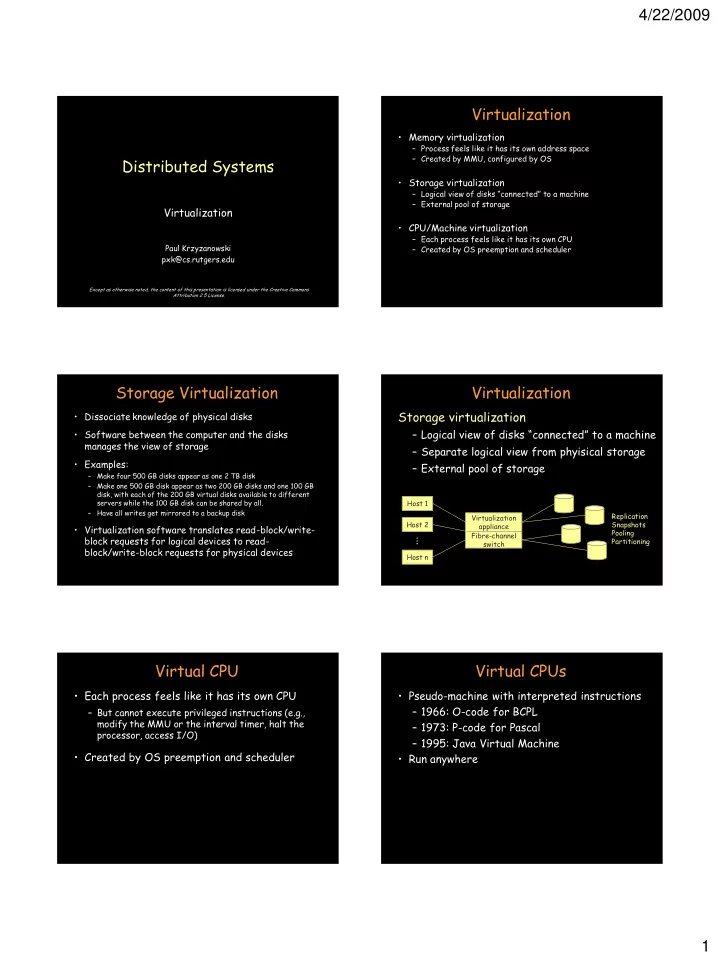

4/22/2009 Virtualization • Memory virtualization – Process feels like it has its own address space – Created by MMU, configured by OS Distributed Systems • Storage virtualization – Logical view of disks “connected” to a machine – External pool of storage Virtualization • CPU/Machine virtualization – Each process feels like it has its own CPU Paul Krzyzanowski – Created by OS preemption and scheduler pxk@cs.rutgers.edu Except as otherwise noted, the content of this presentation is licensed under the Creative Commons Attribution 2.5 License. Storage Virtualization Virtualization Storage virtualization • Dissociate knowledge of physical disks – Logical view of disks “connected” to a machine • Software between the computer and the disks manages the view of storage – Separate logical view from phyisical storage • Examples: – External pool of storage – Make four 500 GB disks appear as one 2 TB disk – Make one 500 GB disk appear as two 200 GB disks and one 100 GB disk, with each of the 200 GB virtual disks available to different servers while the 100 GB disk can be shared by all. Host 1 – Have all writes get mirrored to a backup disk Replication Virtualization Host 2 Snapshots appliance • Virtualization software translates read-block/write- Pooling Fibre-channel block requests for logical devices to read- ... Partitioning switch block/write-block requests for physical devices Host n Virtual CPU Virtual CPUs • Each process feels like it has its own CPU • Pseudo-machine with interpreted instructions – 1966: O-code for BCPL – But cannot execute privileged instructions (e.g., modify the MMU or the interval timer, halt the – 1973: P-code for Pascal processor, access I/O) – 1995: Java Virtual Machine • Created by OS preemption and scheduler • Run anywhere 1
4/22/2009 Virtual Machines Machine Virtualization • Machine virtualization • Privileged vs. unprivileged instructions – Partition a physical computer to act like • Regular applications use unprivileged several real machines instructions – Migrate an entire OS + applications from – Easy to virtualize one machine to another • If regular applications execute privileged • 1972: IBM System 370 instructions, they trap – VM catches the trap and emulates the instruction Intel Ugliness Virtual Machine Monitor (VMM) • Intel x86 arch < Core 2 Duo doesn’t support • Program in charge of virtualization trapping privileged instructions – Aka Hypervisor – Arbitrates access to physical resources • Two approaches – Presents a set of virtual device interfaces to each – Binary translation (BT) host • Scan instruction stream and replace privileged • Guest OS runs until: instructions with something the VM can intercept. – Privileged instruction traps (VMware approach) – System interrupts – Paravirtualization – Exceptions (page faults) • Don’t use non -virtualizable instructions (Xen approach) – Explicit call: VMCALL (intel) or VMMCALL (AMD) Architectural Support Popular VM Platforms • Intel Virtual Technology (Intel Core 2 Duo) • Xen – Runs under an OS and provides virtual containers for running • AMD Opteron other operating systems. Runs a subset of x86. Routes all hardware accesses to the host OS. • Certain privileged instructions are • Altris Software Virtualization Services intercepted as VM exits to the VMM – Windows registry & directory tweaking – Allows multiple instances of applications to be installed • Exceptions, faults, and external interrupts • Microsoft Virtual Server are intercepted as VM exits • Parallels • Virtualized exceptions/faults are injected as VM entries • VMWare 2
4/22/2009 Security Threats Muiltiprocessor Virutalization • Hypervisor-based rootkits • 3Leaf Systems – Custom ASIC to allow networked • A system with no virtualization software processors to act like one SMP system installed but with hardware-assisted – Cache-coherent links between servers virtualization can have a hypervisor-based • A connection between servers keeps memory rootkit installed. coherent and makes a remote processor look like it’s on the same system bus • Rootkit runs at a higher privilege level than – Planned for 2010 the OS. It’s possible to write it in a way that the kernel will have a limited ability to detect it. The end 3
Recommend
More recommend